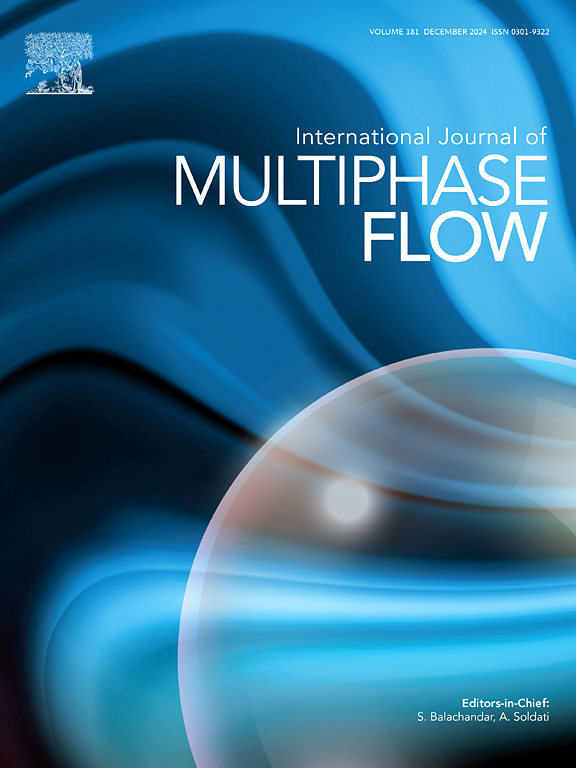团簇湍流CFD-DEM模拟的网格独立性研究
IF 3.6
2区 工程技术
Q1 MECHANICS
International Journal of Multiphase Flow
Pub Date : 2025-04-05
DOI:10.1016/j.ijmultiphaseflow.2025.105223
引用次数: 0
摘要
我们提出了三种不同的粒子(数据)映射方法对无界流化系统中各种一点和两点簇致湍流(CIT)统计量的影响的比较研究。这些方法包括粒子质心法(PCM)、分割粒子体积法(DPVM)和一种新提出的高斯核方法的实现,即GaussFace方法。在PCM方法中,将整个粒子数据分配到粒子质心所在的单元中。然而,在DPVM中,使用卫星点方法将颗粒数据细分为更小的体积,从而允许颗粒属性在与卫星点相关的单元之间分布。我们在2.22dp - 8.88dp和两个平滑特征尺寸之间进行了稀释和密集系统的模拟。我们的研究结果表明,与PCM和DPVM相比,单独使用基于高斯核将粒子数据分布到周围细胞的GaussFace方法可以获得更平滑的粒子场。此外,我们发现只有通过GaussFace方法和随后的平滑才能获得网格无关的结果。我们还观察到,为稀系统所确定的网格无关准则对致密系统也是有效的。此外,对比两种不同的分离空间相关和不相关粒子速度分量的方法表明,通常采用的固定滤波方法严重低估了稀区颗粒温度。我们的研究结果可以为获得高分辨率的CFD-DEM结果提供参考,从而可以用于开发粗网格模型。本文章由计算机程序翻译,如有差异,请以英文原文为准。

On grid-independency of CFD-DEM simulations of cluster-induced turbulence
We present a comparative study on the influence of three different particle (data) mapping methods on various one-point and two-point cluster-induced turbulence (CIT) statistics in an unbounded fluidization system. These methods include the particle centroid method (PCM), the divided particle volume method (DPVM), and a newly proposed implementation of Gaussian kernel method referred to as GaussFace method. In PCM method, the entire particle data is allocated to the cell, in which the particle centroid is located. However, in DPVM, the particle data is subdivided into smaller volumes using a satellite point method, allowing the distribution of particle properties among the cells associated with the satellite points. We performed simulations of dilute and dense systems at grid sizes between 2.22 and two smoothing characteristic sizes. Our results reveal that solely using GaussFace method, which is based on distributing particle data to surrounding cells employing a Gaussian kernel, leads to a smoother particle field compared to the PCM and DPVM. Furthermore, we find that grid-independent results can only be obtained by GaussFace method together with subsequent smoothing. We also observe that the grid-independence criterion identified for the dilute system is also valid for the dense system. In addition, comparing two different methods of separating the spatially correlated and uncorrelated particle velocity components reveals that the commonly adopted fixed filter approach grossly underestimates the granular temperature in the dilute regions. The findings of our study can serve as a reference for obtaining high-resolution CFD-DEM results, which, in turn, can be used to develop coarse-grid models.
求助全文
通过发布文献求助,成功后即可免费获取论文全文。
去求助
来源期刊
CiteScore
7.30
自引率
10.50%
发文量
244
审稿时长
4 months
期刊介绍:
The International Journal of Multiphase Flow publishes analytical, numerical and experimental articles of lasting interest. The scope of the journal includes all aspects of mass, momentum and energy exchange phenomena among different phases such as occur in disperse flows, gas–liquid and liquid–liquid flows, flows in porous media, boiling, granular flows and others.
The journal publishes full papers, brief communications and conference announcements.

 求助内容:
求助内容: 应助结果提醒方式:
应助结果提醒方式:


